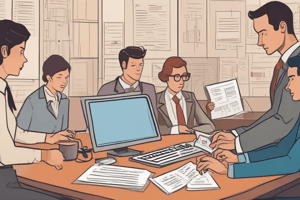Podcast
Questions and Answers
What is the primary role of an Incident Commander (IC) in KCFD?
What is the primary role of an Incident Commander (IC) in KCFD?
- To manage responding resources according to incident needs (correct)
- To provide medical treatment to patients
- To oversee all ambulances in the area
- To assess the qualifications of uniformed personnel
Which statement correctly characterizes a 'Patient' as defined by KCFD?
Which statement correctly characterizes a 'Patient' as defined by KCFD?
- A person in need of treatment by medical personnel (correct)
- Anyone who has not activated the EMS system
- Any individual present at the incident location
- A bystander at an emergency scene
What should the Incident Commander do if they determine that no responding resources are required?
What should the Incident Commander do if they determine that no responding resources are required?
- Proceed with the initial assessment of the scene
- Request additional resources for medical support
- Inform Communications to downgrade the response (correct)
- Automatically report a false alarm
What information must be reflected in the incident report according to the guidelines?
What information must be reflected in the incident report according to the guidelines?
Who does not qualify as a 'Patient' in the context of KCFD guidelines?
Who does not qualify as a 'Patient' in the context of KCFD guidelines?
Which of the following best describes the scope of this guideline?
Which of the following best describes the scope of this guideline?
When evaluating the necessity of resources, what is the first step for the Incident Commander?
When evaluating the necessity of resources, what is the first step for the Incident Commander?
What is the responsibility of the Incident Commander regarding the communication of assessment findings?
What is the responsibility of the Incident Commander regarding the communication of assessment findings?
Flashcards are hidden until you start studying
Study Notes
Purpose
- Outlines practices for KCFD Incident Commanders to manage resources effectively based on incident needs.
Scope
- Applies to all uniformed KCFD personnel and resources, notably ambulances.
Definitions
- Incident Commander (IC): Officer from a responding KCFD apparatus who leads and establishes command at an incident.
- Patient: Individual needing treatment from medical personnel, including those who activated EMS or present with a medical complaint.
- Not a Patient: Individual identified as not needing treatment, regardless of potential involvement in situations leading to a medical need.
Guidelines
- Following Command establishment and scene assessment:
- IC assesses necessary KCFD resources for incident management.
- If no resources are needed, IC will notify Communications to cancel or downgrade the response to non-emergency status.
- Incident reports must document that a scene assessment occurred with no patients identified.
- Example narrative for report: "A scene assessment was conducted; no patients requiring medical care were presented."
Studying That Suits You
Use AI to generate personalized quizzes and flashcards to suit your learning preferences.




